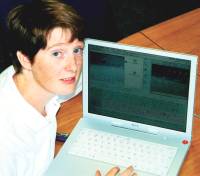Candid camera analysis designed to build team performance
09 December 2002 Visual aid: Michele Boddington's PhD thesis explores video analysis as a tool for enhancing skilled sports performances.
Visual aid: Michele Boddington's PhD thesis explores video analysis as a tool for enhancing skilled sports performances.
Using qualitative video analysis techniques, Boddington has been able to help coaches fine-tune and boost their team (and individual) performances. Video analysis, she says, is the way of the future, if you want to get to the top and remain there.
The Brighton University BSc (Sports Science) student came to South Africa four years ago to begin her Masters degree, later upgrading this to a PhD.
“I felt there was no scope for me to leave UCT with a Masters as I hadn't reached the point where I felt I could go into industry,†she says. Although the physical aspects of sports has been studied, the skills aspects offers scope for investigation, giving rise to the idea of video feedback techniques that will enhance skilled performance.
Using SportsCode, a sports analysis system that offers advanced sports analysis to teams and individuals, Boddington measures the efficacy of visual feedback to boost skilled performance among athletes and sportspeople.
Although her studies have allowed her to work with elite gymnasts and cricket players, her focus has been on women hockey players, from the national side, to the provincial and club levels. “I was a reasonable club level hockey player in the United Kingdom, probably the equivalent of provincial level, and the question 'how do we train?' became all-important,†she explained.
“This study shows that the use of visual feedback can enhance performance whether in tactical changes to team formation or during set pieces. Both of these areas can determine the success or failure of performance.â€
The information helps coaches understand the physical and skilled elements of their sport and assists them in developing more appropriate training interventions.
While some coaches may be wary of the technological aid, it is not intended to replace them. “The information helps them understand the physical and skilled elements of their sports and assists them in developing more appropriate training interventions,†Boddington explains.
By using the analysis coaches are also able to pick up injury-causing techniques, for example, in bowlers. “It could mean ensuring that a 17-year old great will go on to become great,†she commented.
The Unit's Associate Professor Mike Lambert agrees. “Michele's studies have used cutting edge technology to analyse movement patterns in sport and if applied correctly, her data will contribute significantly to improving sporting performance while reducing the risk of injury.
"Michele will be staying in Cape Town doing postdoctoral work next year so hopefully there will be opportunities for her to get involved in a variety of sports.â€
 This work is licensed under a Creative Commons Attribution-NoDerivatives 4.0 International License.
This work is licensed under a Creative Commons Attribution-NoDerivatives 4.0 International License.
Please view the republishing articles page for more information.
Related
Celebrating UCT’s outstanding Thuthuka results
29 Dec 2025
Looted African belongings must be returned
29 Dec 2025
Republished










